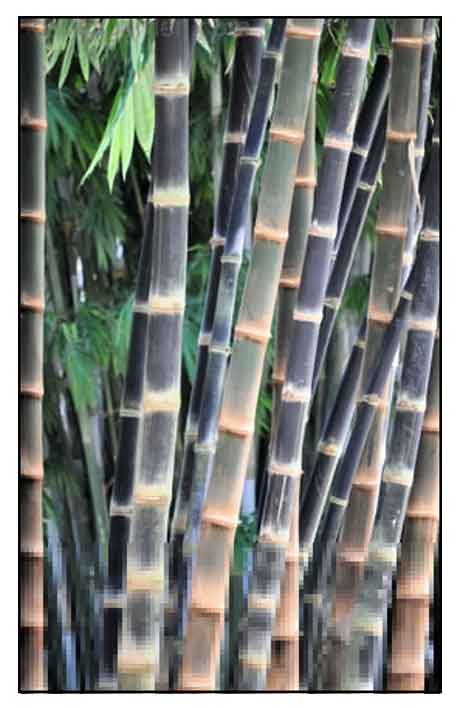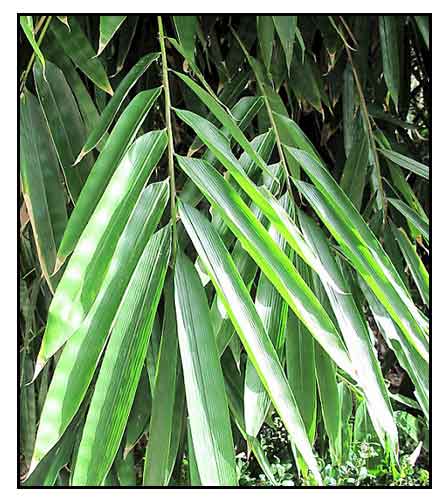 Gen info Gen info
- Dendrocalamus asper is one of the seven most commercially marketed shoots in China, Thailand and Taiwan.
- It has recently been grown under a commercial setting. EcoPlanet Bamboo is the first to grow D. asper from seed with the development of a million plant nursery. In 2015, EcoPlanet Bamboo became the first entity globally to grow the species commercially in partnership with the Ghana Forestry Commission.
(4)
- In Thailand, planted area of D. asper is estimated at 6000 ha. In Prachinburi Province, shoot production in 1984 was 37.975 t from 4465 ha. Price was 2-8 Baht/kg, depending on time of year. (8)
Botany
Dendrocalamus asper is a giant tropical, dense-clumping species, growing 15 to 20 meters tall, 8 to 12 centimeters in diameter. Culms are grayish green, becoming dull brown on drying. Lower nodes of young culms are covered with golden brown hairs. Young shoots are brownish black. Internode length is 25 to 60 centimeters. Culm walls are generally very thick. Nodes are prominent. Culm sheath is straw-colored, large and broad; the top of the sheath rounded, the auricles small. Mature culms grown very straight, tapering only at the upper level, showing very little branching. Flowers are intermittent, with long time intervals. Seed is very fragile, with high seedling mortality. (4)
Distribution
- Native to the Philippines. (1)
- Also native to Andaman Is., Bangladesh, Borneo, China, Jawa, Laos, Lesser Sunda Is., Malaya, Maluku, Myanmar, New Guinea, Sulawesi, Sumatera, Taiwan, Thailand, Vietnam. (1)
 Constituents Constituents
- Macronutrient analysis (g/100 g fresh weight) of freshly emerged juveniles shoots yielded: amino acids 3.12 ± 0.07, proteins 3.59 ± 0.06, carbohydrates 4.90 ± 0.11, starch 0.36 ± 0.08, fat 0.40 ± 0.06, vitamin C 3.20 ± 0.06, vitamin E 0.91 ± 0.13, ash 0.95 ± 0.03, moisture 89.40 ± 0.98, dietary fiber 3.54 ± 0.07. (3)
- GC-MS pyrolisis of ethanolic extract of leaves showed
major compounds of fatty acids, along with ester, long chain alcohols, and alkehydes. (see study below) (7)
- Chemical composition of culm is approximately: holocellulose 53%, pentosans 10%, lignin 25%, ash 3%, Solubility in cold water is 4.5%, hot water
6%, alcohol-benzene 1%, 1% NaOH 22%. (8)
- Study of crude extract of shoots isolated one new metabolite (11E,13E,17E,19E)-dimethyl-15,16-dibutoxytriaconta-11,13,17,19-tetraenedioate (1), along with four known compounds: ß-sitosterol (2), methyl-4-hydroxybenzoate (3), 1-methoxy-4-(methoxymethyl)benzene (4) and 4-hydroxybenzaldehyde (5). (see study below)
(12)
Properties
- Sympodial, without lateral growth; thus, with no invasive properties. (4)
- Studies have shown nutritional, antibacterial properties.
Parts used
Leaves, shoots..
Uses
Edibility
- Young shoots are eaten as vegetable; also pickled and preserved.
- In Asia, one of the most popular edible bamboo shoots.
- Considered by some as the best among edible tropical Asiatic bamboos.
(8)
- Young stems can be cut into strips and used as substitute for macaroni in soups.
(15)
Folkloric
- No reported folkloric medicinal use in the Philippines.
-
In Indonesia, shoots used for treatment of hypertension. (5)
Others
- Construction: Culms are thick-walled, strong, and durable. Used for heavy construction owing to its straight and large-diameter culms.
- Ethnoveterinary: Leaves used for treatment of diarrhea in animals. (7)
- Cooking pots: In Sarawak, used as cooking pots in the field; the internode is opened at one end or the node, then filled with vegetables, meal, rice, and water, covered and placed on fire. (8)
Studies
• Nutrient Value: In a study of fresh shoots of bamboo species, five species, B. tulda, B. bambos, Dendrocalamus asper, D. gigantea and D hamiltonii were nutritionally better than the rest. Freshly emerging shoots are nutritionally superior to older emerged shoots. While nutrient components of the shoots were depleted with aging, the dietary fiber and moisture contents were increased. Study suggests high potential for the commercial production of shoots. (see constituents above). (3) There was a significant decrease in free amino acids in 10-day-old shoots compared to freshly harvested shoots. Protein content in 8-day shoots,1.21 g/100g fresh weight, decreased to 0.86 g/100g fresh weight after another 10 days. There was a significant rise in carbohydrate content after boiling, which may be due to hydrolysis of complex polysaccharides into single monosaccharide sugar units. Aging was also associated with changes in constituent levels. Boiling in higher concentration of salt for longer duration also decreased the phenol content of shoots. (6)
• Taxiphyllin in Shoots: Bamboo shoots contain varying among of cyanogen glycosides called taxiphyllin. ß-glycosidase which is released in disrupted bamboo shoot tissues acts n taxiphyllin to produced harmful hydrogen cyanide. The harmful cyanide should be removed before human consumption. The most edible species yield high amount of cyanogen glycoside with maximum concentration found at the shoot tip. Shoots with high toxic levels of cyanogenic compounds can be made edible via detoxification with boiling water for about 2 hours. The cyanogen in shoots of D. asper and B. tulda was significantly lowered without much reduction of carbohydrates, proteins, phenols, potassium, phosphorus and sodium when shoots were boiled for 25 minutes i 1%, 5%, and 10% NaCl solution. Superheated steam at over 116°C can also remove HCN. (6)
• Antibacterial / Antidiarrheagenic / E. coli / Leaf: Study evaluated various leaf extracts of D. asper for antibacterial activity against diarrheagenic Escherichia coli. Micro-dilution assay of ethanolic extract of D. asper leaves with yield of 28.47 ± 3.76% (w/w) was most effective in inhibiting E. coli strains. (see constituents above) (7)
• 4-Hydroxybenzoic Acid (4-hba) / Lowering of Membrane Potential / Shoots: 4-hydroxybenzoic acid is a non-flavonoid phenol found abundantly in D. asper shoots, fruits (strawberries and apples) and flowers. Kv1.4 is a rapidly inactivating Shaker-related member of the voltage-gated potassium channels with two inactivation mechanisms playing vital roles in repolarization hyperpolarisation, and signaling the restoration of resting membrane potential through regulation of movement of K+ across cellular membrane. Study showed that 4-hba in D. asper bamboo shoots can enhance the activities of Kv1.4 potassium channels, contributing to the reduction of membrane excitation. Results provide leads to identify other compounds with potential antiepileptic properties. (9)
• Antimicrobial / Nutritional Analysis / Shoots: Study evaluated two samples of bamboo shoots of D. asper for nutritional content and antimicrobial activities. Both bamboo shoots boiled at 100°C for 20 min were high in moisture (>93 g/100 g FW), crude protein (>21 g/100 g DW), and crude fiber contents (> 9 g/100 g DW), but low in fat content (< 4 g/100 g DW). Potassium was the most abundant mineral at 205.67 and 208.83 µg/100 g DW of the two samples. Extracts (hexane, ethyl acetate, ethanol, water) of both shoot samples showed stronger antifungal activity than antibacterial activity. One sample showed stronger inhibition of α-glucosidase and contained higher TPC. (9)
• Antimalarial / Shoots: In search of new potential antimalarial agents, the chemical constituents of shoots were evaluated against the P. falciparum strain 3D7. Study of crude extract isolated one new metabolite, along with four known compounds. Compounds 1, 3, and 4 showed promising antimalarial activity with IC50s between 0.8-2.2 µg/mL. (see constituents above) (12)
• Hemicellulose Dietary Fibers / Young Culms: Study evaluated and characterized different portions (bottom, middle, and top) of young bamboo culm fibrous fractions from Dendrocalamus asper, Bambusa tuldoides, and B. vulgaris. Results showed high amounts of dietary fiber (79-89%). The hemicellulosic polysaccharide contents (35.4-41.5%) showed great potential for commercial extraction. The presence of neutral xylans and arabinoxylans were seen in all studied bamboo species, which has potential as alternative dietary fiber source for use in food industry and in the production of xylooligosaccharides (XOS), biomaterials, and biofuels. (13)
• Hemicellulose Dietary Fibers / Young Culms: Study evaluated the hydroxypropyl cellulose (HPC) powder from α-cellulose Betung bamboo and its potential for tablet formulation. Based on comparison of powder characteristics and tablet evaluation, HPC BB has great potential for tablet formulation. (14)
Availability
- Wild-crafted.
- Cultivated.
- Seeds in the cybermarket.
|

![]()



 Gen info
Gen info Constituents
Constituents